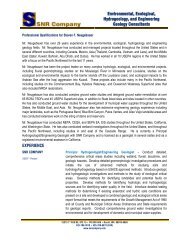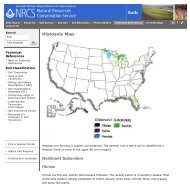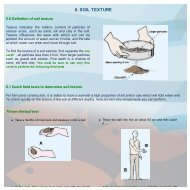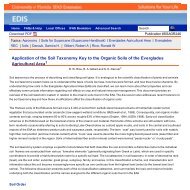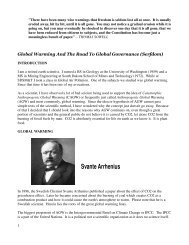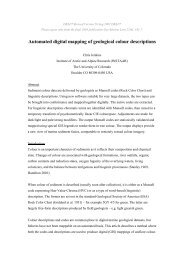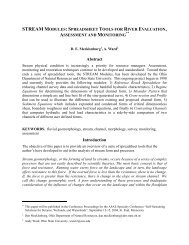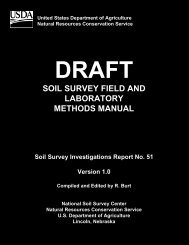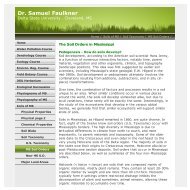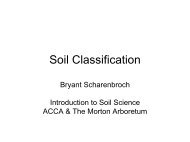chapter 3 fundamentals of fluvial geomorphology and stream ...
chapter 3 fundamentals of fluvial geomorphology and stream ...
chapter 3 fundamentals of fluvial geomorphology and stream ...
Create successful ePaper yourself
Turn your PDF publications into a flip-book with our unique Google optimized e-Paper software.
Table 3.1 – Classification <strong>of</strong> theSediment LoadMeasurementmethodTransportmechanismSedimentsourceUnmeasured LoadBed LoadBed Material LoadMeasured LoadSuspended LoadWash Load3.5 CHANNEL-FORMINGDISCHARGEMorphological studies have revealed that channel formdepends on a delicate balance between the flows <strong>of</strong> water <strong>and</strong>sediment that shape the <strong>stream</strong>, the processes by which channelform is changed, <strong>and</strong> the ability <strong>of</strong> the boundary materials to resistchange. Variability <strong>of</strong> the water <strong>and</strong> sediment discharges is acharacteristic <strong>of</strong> the watershed <strong>and</strong>, if maintained over asufficiently long period, the morphology <strong>of</strong> the <strong>stream</strong> will adjust toaccommodate the range <strong>of</strong> flow events responsible for regulatingthe balance between the erosive <strong>and</strong> resistive forces that mold the<strong>stream</strong>. Consequently, the shape <strong>and</strong> dimensions <strong>of</strong> an alluvialriver channel are adjusted to <strong>and</strong> reflect the wide range <strong>of</strong> flowsthat entrain, transport, <strong>and</strong> deposit boundary sediments (Lane1955). The concept that there is a single discharge which, if itprevailed all the time, would produce the same width, depth, slope,hydraulic roughness, <strong>and</strong> planform as those produced by theactual range <strong>of</strong> discharges, is attractive, but viewed in this contextit is clearly a gross simplification. The single discharge best ableto represent the actual spectrum <strong>of</strong> sediment-transporting eventsto yield the same bankfull morphology as that shaped by thenatural sequence <strong>of</strong> flows is referred to as the channel-formingflow or the dominant discharge. Dunne <strong>and</strong> Leopold (1978)defined <strong>stream</strong> maintenance flow as the most effective dischargefor moving sediment, forming or removing bars, forming orchanging bends <strong>and</strong> me<strong>and</strong>ers, <strong>and</strong> generally doing work thatresults in the average morphologic characteristics <strong>of</strong> <strong>stream</strong>s.Their definition <strong>of</strong> <strong>stream</strong> maintenance flow is very similar to theconcept <strong>of</strong> channel-forming discharge.In a regulated canal system, the dimensions <strong>of</strong> the <strong>stream</strong>can appropriately be based on a single design discharge <strong>and</strong>empirical analysis <strong>of</strong> the relationship between that discharge <strong>and</strong>the dimensions for a stable, unlined canal formed in alluvialmaterials produced the regime theory. Early work on regimetheory stems from design <strong>of</strong> straight canals in the Indian sub-Fundamentals <strong>of</strong> Fluvial Geomorphology <strong>and</strong> Stream Processes 33



